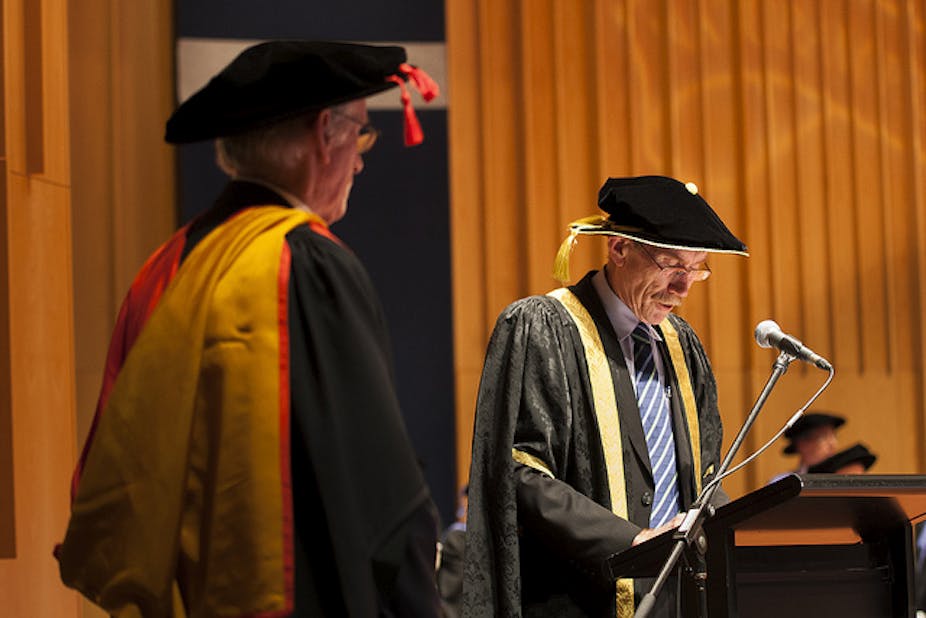Women make up 64% of Pro Vice Chancellors, 65% of Deputy Vice Chancellors and 77% of Vice Chancellors in Australian universities.
Would such a headline cause a reader to re-scan the article to make sure it was correct? Would there be an outcry about women in university leadership roles if this headline were accurate? And why is there an apparent indifference given these are the correct figures for male leaders in our universities?
The persistent numerical imbalance of women and men at senior levels in universities does not appear to be cause for concentrated and wider concern. This might be explained by underpinning assumptions that men “naturally” lead and that management is a masculine domain.
Paradoxically, although many universities host research centres and acclaim the intellectual contribution of academics engaged in research in the areas of gender, work, and organisations, a blind eye appears to have been turned as to how gender equity might be applied in the workplace.
There has been an unprecedented growth in the enrolment of women in higher education over the past four decades. Since 1970 the number of female students has grown twice as quickly as that of men. But the good news ends there.
This dramatic growth is not reflected in the workforce demographics. Studies by the OECD and UNESCO in 2010 show that despite having the same or better qualifications, women have not made significant progress in terms of salary, promotion or a marked increase in representation at senior levels.
And those women in senior leadership roles are caught in an institutional spotlight and accordingly judged as leaders and as women, rather than just as leaders, as their male counterparts are.

An even bleaker revelation reported recently in the Times Higher Education was that of the 18,500 professors in the UK, only 85 are black and a mere 17 of these are black women.
Nations such as Iceland, Norway, Finland, Sweden and Israel have higher numbers of women in senior leadership roles. Positive initiatives such as gender mainstreaming, affirmative action strategies, as well as quotas and targets have brought about a number of changes that have created more socially inclusive and sustainable workforces.
Yet despite affirmative action strategies in Australia, England, and New Zealand such as flexible work and leave practices, gender balances on appointments and promotions committees, and an increasing awareness of unconscious bias, there has been a glacial shift forwards.
In many ways, an unintended consequence of legislative change such as the Equal Employment Opportunity act and more transparent institutional reporting on staff tenure, positions and salaries, has been that gender appears to be no longer on the agenda.
What needs to be done?
In the first instance, there is a need to reinvigorate debates about leaders and leadership in higher education. We ought to cast aside assumptions about what makes a “good” leader as this invariably leads to an unconscious bias that when we think “leader” we think “male”. This further suggests that women who venture into senior management are transgressors; that they have strayed onto the playgrounds of male power.
Second, we need to think beyond simply counting more women in by increasing their numbers. While numbers are important to create a critical mass, it is a change in attitude towards female leaders that is needed.
Third, women are frequently appointed for their relational, collaborative and participatory skills; skills that are required in 21st century organisations and skills that presumably their male colleagues do not “naturally” possess. We need to move away from attributing leadership styles to both genders.
Women are travellers in a male world in which they are confronted with expectations of being managerial (read masculine) enough to be acknowledged as managers, yet feminine enough to be recognised as women. But to be accepted, they need to conform to established stereotypes and stay out of powerful positions.
How can we rattle the managerial cage?
The first step is to dismantle narrow and gendered constructions of leaders and leadership and to promote thinking about how workplaces and work practices can become more democratic, inclusive and socially just. Thinking more broadly about the characteristics required for 21st century leadership has the potential to liberate both women and men from institutionalised ideas about leadership.
Second, serious questions need to be raised about universities. Worryingly, the academy’s own claim to be the custodian and site of liberal ideas has failed in the arena of gender relations. There are profound silences in regard to discourses of human rights, democracy and social justice, questions about equity and diversity within leadership and more collaborative and socially democratic ways of leading and managing.
Equity and diversity is a leadership dilemma, and with a mandate to be the critic and conscience of society, universities need to step up to their mission.

